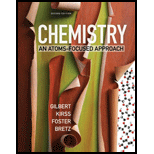
To find:
a. Limiting reactant in a reaction mixture of
(i)
(ii)
b. How many grams of
c. How much of which reactant is left over in the reaction mixture in part (i)?
Answer to Problem 7.81QA
Solution:
a. Limiting reactant in a reaction mixture of
b.
c.
Explanation of Solution
1) Concept:
Limiting reactant: It is defined as the reactant, which is completely consumed in the
Excess of reactant: The reactant, which is left over to some extent in unreacted form after completion of reaction.
Amount of excess of reactant can be calculated by subtracting the amount reacted from the initial amount of reactant.
i.e.,
Percent yield is the percent of amount of product formed.
i.e.,
where,
2) Formula:
3) Given:
i)
ii)
iii)
4) Calculation:
a. Limiting reactant:
Given reactions are:
i)
ii)
Reaction mixture contains
Calculate the moles of both
(To solve this problem, we need to consider
Calculate the mass of
The mole ratio between
The mole ratio between
(To solve this problem, we need to consider
(To solve this problem, we need to consider
The amount of
b. Mass of
From part a, we know that
From reaction (ii), the mole ratio of
This is the theoretical yield, but the yield from (ii) is 95%, so the formula for percent yield is
Re-arranging it for actual yield,
c. Mass of excess of reactant in reaction (i):
(To solve this problem, we need to consider
Calculate the mass of
Mole ratio of
(To solve this problem, we need to consider
Calculate the amount of
Therefore,
(To solve this problem, we need to consider
Conclusion:
We determined the limiting reactant from the reactant’s masses and found out the excess of reactant. Using the percent yield, actual yield is calculated.
Want to see more full solutions like this?
Chapter 7 Solutions
CHEM:ATOM FOC 2E CL (TEXT)
- H I T H HH H -H C. H- Identify and select all structures below that represent a constitutional isomer(s) of the compound shown above. H- H CIH H H H HHHH H H 0 ·H H– 冊 CH CHI HH C- H- H H- H H A. H H C H H- -H HH H B. H- -H D. H H H H • H -H E. -H H H HICH T HHH F. H-arrow_forwardPolylactic acid (shown below) is a biodegradable polymer used for food packaging. Identify the monomer(s) used in the production of this polymer using a condensation process.arrow_forwardDraw the product of the reaction shown below. Ignore small byproducts that would evaporate pleasearrow_forward
- Poly(ethylene adipate) is a biodegradable polyester (shown below). Identify the type of polymerization process used in the production of this polymer.arrow_forwardPolymers may be composed of thousands of monomers. draw two repeat units(dimer) of the polymer formed in this reaction. assume there are hydrogen atoms on the two ends of the dimer. ignore inorganic byproducts pleasearrow_forwardDraw the product of the reaction shown below. Use a dash or wedge bond to indicate stereochemistry of substituents on asymmetric centers, Ignore inorganic byproductsarrow_forward
- Draw the product of this reaction please. Ignore inorganic byproductsarrow_forwardOne of the pi molecular orbitals of 1,3-butadiene (CH2=CHCH=CH2) is shown below. Please identify the number of nodal planes perpendicular to the bonding axisarrow_forwardDraw the monomers required to synthesize this condensation polymer please.arrow_forward
- Provide the correct systematic name for the compound shown here. Please take into account the keyboard options belowarrow_forwardcurved arrows are used to illustrate the flow of electrons. using the provided starting and product structures, draw the curved electron-pushing arrows for the following reaction or mechanistic step(s)arrow_forwardIdentify the 'cartoon' drawing of the acceptor orbital in the first mechanistic step of an electrophilic addition reaction of butadiene with HBr. Pleasearrow_forward
 ChemistryChemistryISBN:9781305957404Author:Steven S. Zumdahl, Susan A. Zumdahl, Donald J. DeCostePublisher:Cengage Learning
ChemistryChemistryISBN:9781305957404Author:Steven S. Zumdahl, Susan A. Zumdahl, Donald J. DeCostePublisher:Cengage Learning ChemistryChemistryISBN:9781259911156Author:Raymond Chang Dr., Jason Overby ProfessorPublisher:McGraw-Hill Education
ChemistryChemistryISBN:9781259911156Author:Raymond Chang Dr., Jason Overby ProfessorPublisher:McGraw-Hill Education Principles of Instrumental AnalysisChemistryISBN:9781305577213Author:Douglas A. Skoog, F. James Holler, Stanley R. CrouchPublisher:Cengage Learning
Principles of Instrumental AnalysisChemistryISBN:9781305577213Author:Douglas A. Skoog, F. James Holler, Stanley R. CrouchPublisher:Cengage Learning Organic ChemistryChemistryISBN:9780078021558Author:Janice Gorzynski Smith Dr.Publisher:McGraw-Hill Education
Organic ChemistryChemistryISBN:9780078021558Author:Janice Gorzynski Smith Dr.Publisher:McGraw-Hill Education Chemistry: Principles and ReactionsChemistryISBN:9781305079373Author:William L. Masterton, Cecile N. HurleyPublisher:Cengage Learning
Chemistry: Principles and ReactionsChemistryISBN:9781305079373Author:William L. Masterton, Cecile N. HurleyPublisher:Cengage Learning Elementary Principles of Chemical Processes, Bind...ChemistryISBN:9781118431221Author:Richard M. Felder, Ronald W. Rousseau, Lisa G. BullardPublisher:WILEY
Elementary Principles of Chemical Processes, Bind...ChemistryISBN:9781118431221Author:Richard M. Felder, Ronald W. Rousseau, Lisa G. BullardPublisher:WILEY





